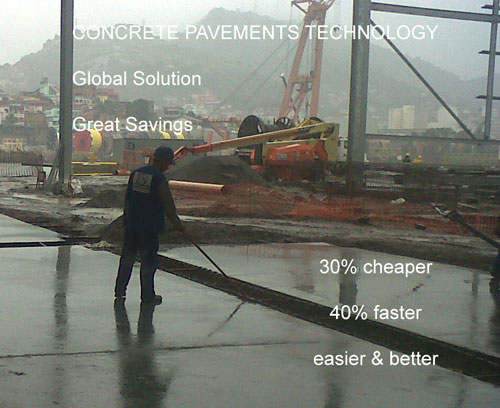
The monolithic foundation system (THE SPWS SLAB-FOUNDATION SYSTEM), compared to the traditional system of concrete pavements and asphalt bituminous, offers the following advantages:
Enables cheaper works through reduction of quantities of materials and of tasks, quantity of heavy equipment required and skilled labour for these devices;
Enables faster construction, and the reduction of duties is important for this reduction;
Works 30% cheaper and 40% faster.
Efficiency up to
(i) 45,000 m2 / 8h shift / by Slip Form, and
(ii) 1200 m2 / 8h shift / with Vibrating Straightedge
High resilient concrete unreinforced and without any fibbers;
The existence of the joint inductor avoids the need for dilation and retraction joints altogether.
Effective tightness of joints preventing liquid infiltration to and from the base avoids totally the need for sealing the joints;
More environmentally friendly and less polluting construction;
Possibility of use of light equipment;
Avoid the need of piles in natural grounds with a very low CBR;
Pavement continuity with less than 1 mm unevenness in case of differential settlement;
Flat and levelled floors with no more than 2 mm dissemblance;
Durability of our solution is much higher than traditional asphalt and bitumen solution once it does not degrade with exposure to sunlight, temperature variations, and the very presence of oxygen, ice, rain or moisture.
Has a greatly more reduced effect on the environment since the amount of recyclable materials is almost total;
Better construction with decreased costs.
COMPARISON WITH THE CONVENTIONAL CONSTRUCTION TECHNIQUES
The pavements construction is based on a base (foundation), once soils are not inert matter, on the contrary they are living matter (they increase and decrease volume with rain and dry weather).
The first steps consist in the cleanup and removal of the topsoil (unsuitable for construction) in order to open a box on the natural ground. In traditional techniques it is necessary to construct a base and sub-base, consisting of compressed selected land (tout venant - crusher run), followed by an inert layer (gravel and sand) giving up over a sprinkling with tar so as to provide some consistency these two layers of loose materials.
Only then, still in the traditional techniques, overlapping the two structural layers (i) to flexible two layers of asphalt pavements (bitumen), the latter being for wear and tear, and (ii) for concrete pavements a lean concrete layer (100 kg cement / m3 with 0.15 m to 0.20 m high) preceding a layer of concrete which constitute the slabs.
ASPHALT – LAYERS

The asphalt degrades by wear and by UHV rays. Even though the asphalt pavement is not used after 7 years ultraviolet rays degrade and asphalt layers no longer linkers starting to loose asphalt gravel.
The asphalt enters into repair between 6 months to 2 years; coming from there continuous maintenance and continuous repair throughout the life of the pavement.
CONVENTIONAL CONCRETE PAVEMENTS LAYERS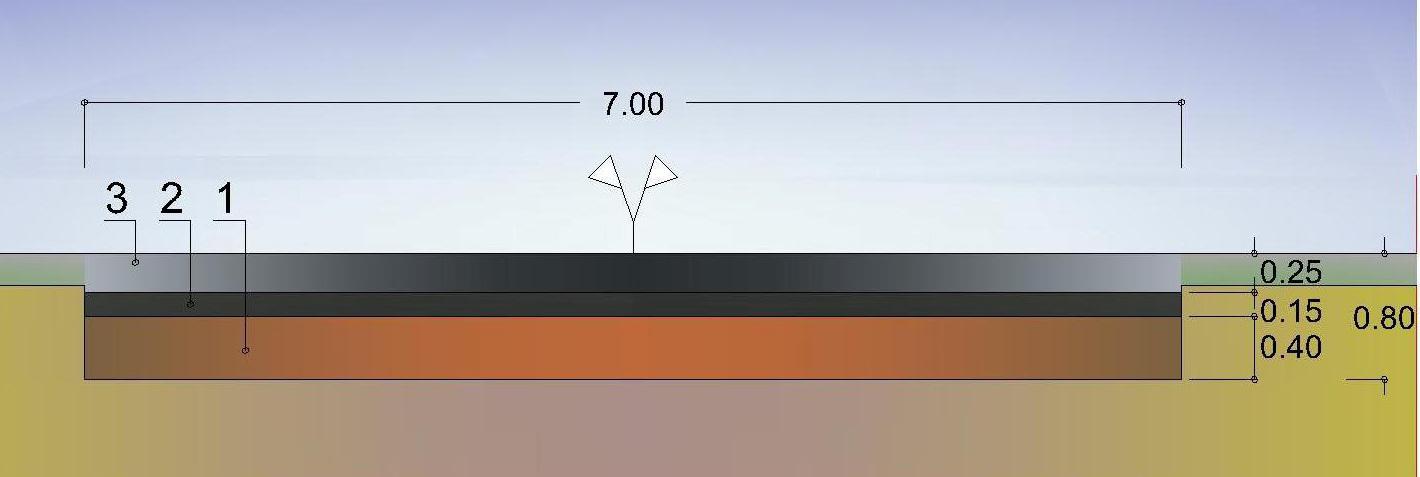
After a century of experience, it can be said that the traditional technical solutions does not effectively meet its objectives proving badly for not having any reliable application in soils continuously subject to differential settlements and to soil distortions. For all this time concrete pavements with load transfer bars always broke the slabs as they do not admit significant differences settlements, all originating expensive and ineffective repairs.
Our monolithic foundation system technology (the SPWS CONCRETE SLAB-FOUNDATION SYSTEM) replaces the classical foundation by:
a) a layer of E.P.S. (high density expanded polystyrene) (5 cm to 30 cm) (also an inert); or
b) a layer of compressed sand (or other inert);
both assuming immediate concrete pavement construction over the base.
SCIENTIFIC PAVEMENT SPWS
SPWS CONCRETE SLAB-FOUNDATION SYSTEM LAYERS
 The blocks of E.P.S. replace so much more effective inert stabilization layers, for maintaining a neutral, durable and without significant changes in their mechanical behaviour throughout the life project, still being easy and quick to apply.
The blocks of E.P.S. replace so much more effective inert stabilization layers, for maintaining a neutral, durable and without significant changes in their mechanical behaviour throughout the life project, still being easy and quick to apply.
This technology not only eliminates the lean concrete layer and the load transfer bars of the middle of the concrete slabs (and tensions caused by the load transfer bars on the slab) and also eliminates the need for construction of traditional foundations all layers to them are necessary.
Thus the concrete pavement may be constructed continuously with only two layers - E.P.S. (or compacted sand as base) and spread the concrete immediately above.
TWO LAYERS ONLY
THE CONSTRUTION SPEED IS EXTRAORDINARY
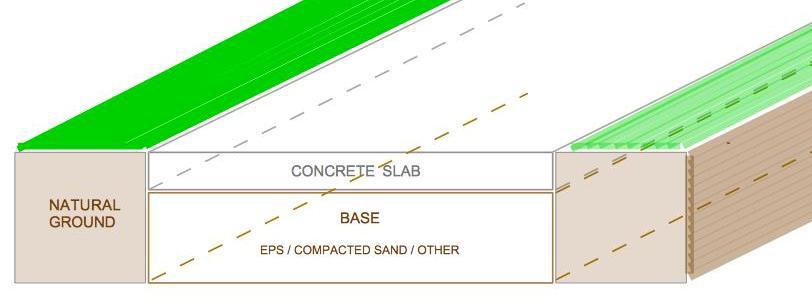
MATHEMATICAL AND SCIENTIFIC CALCULATIONS
LOADS DEGRADE INSIDE THE SLAB ARRIVING TO THE GROUND FOR A LESSER VALUE OF ITS C.B.R.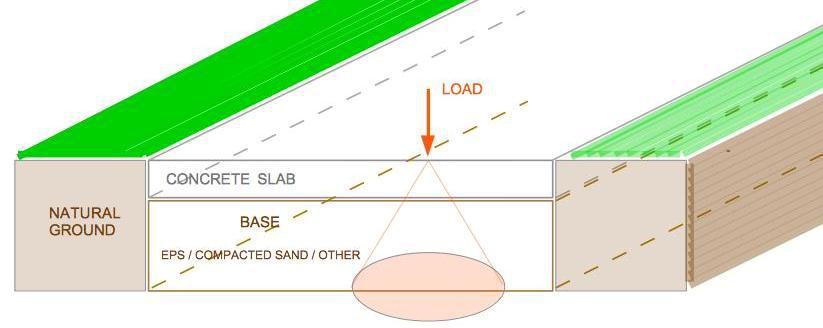
The slabs may slide freely on the E.P.S. base (or compacted sand wrapped in geotextile fabric) perpendicular to the joint without causing any tension arising out of concrete expansion or contraction.
The rotational movement allowed by the load transfer plates ensures perfect continuity of the pavement in the case of differential settlement of the ground in more than 25 mm without any damage to the slabs.
OUR LOAD TRANSFER PLATES ENSURE HORIZONTAL AND VERTICAL MOVEMENTS OF THE SLABS
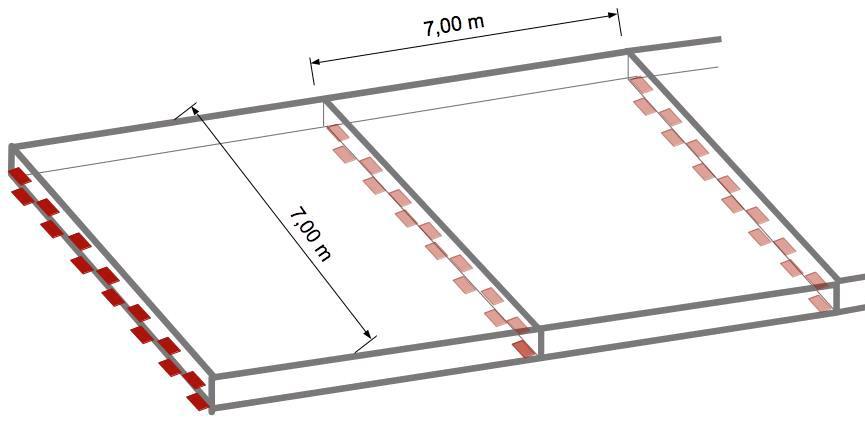
High resilient concrete composition according to IS.COM mix ensures that never becomes necessary to reinforce the concrete and to use fibbers, all meaning huge savings.
Our steel load transfer plates include a joint inductor which ensures the opening of the joints without any mechanical intervention and exactly at middle of the steel load transfer plates, and simultaneously prevents any seepage (watertight joints) from and to the base, eliminating the "pumping" phenomenon.
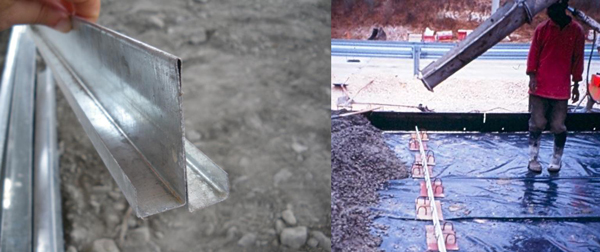
JOINT OPENING WITHOUT ANY MECHANICAL INTERVENTION
JOINTS SAWN IN FRESH
SAWING THE JOINTS MAY BE UNNECESSARY IN ROADS AND MOTORWAYS/HIGHWAYS
UNNECESSARY SEALING OF THE JOINTS
THE JOINTS ARE VERY THIN AND SEEPAGE
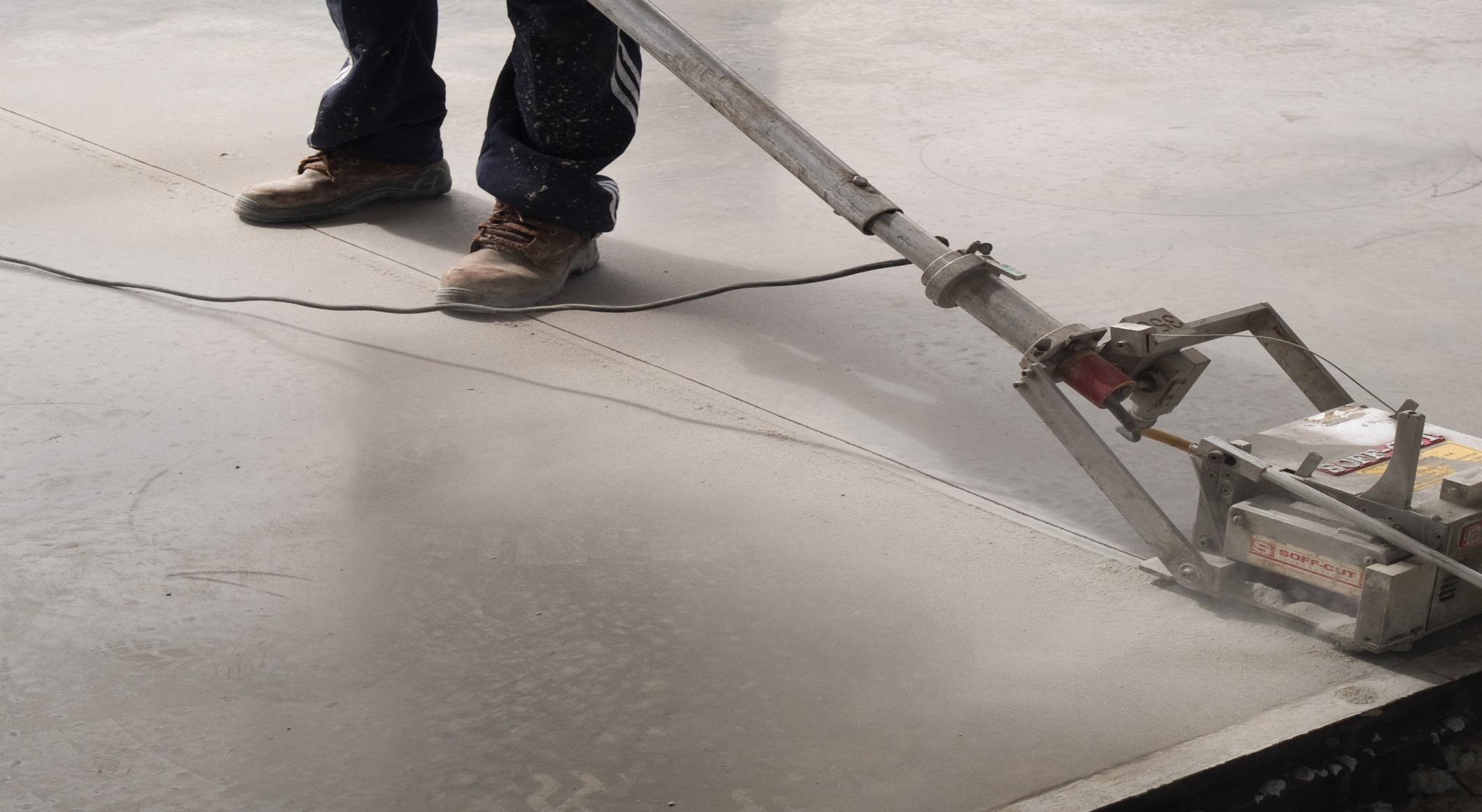
THE CONSTRUTION PRICE IS LOWER THAN THE TRADITIONAL TECHNIQUES









